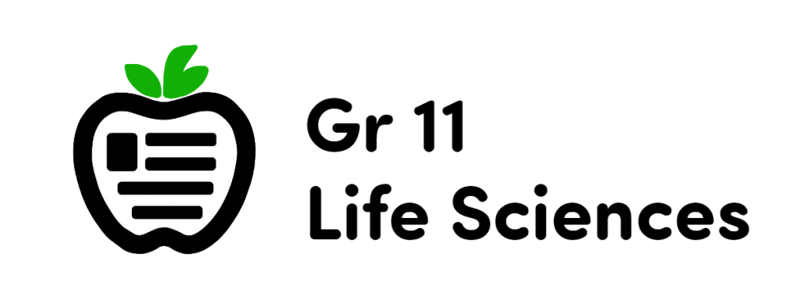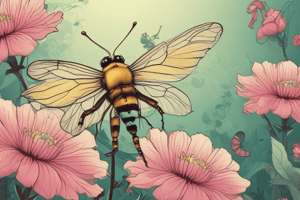Podcast
Questions and Answers
What is the primary purpose of the adaptations seen in flowers for pollination?
What is the primary purpose of the adaptations seen in flowers for pollination?
- To discourage pollinators from visiting
- To reduce genetic diversity
- To ensure the beauty of the flowers
- To maximize reproductive success (correct)
Which feature of insect-pollinated flowers serves as a visual attraction for pollinators?
Which feature of insect-pollinated flowers serves as a visual attraction for pollinators?
- Clumped pollen grains
- Reduced floral complexity
- Conspicuous petals (correct)
- Dilute nectar rewards
What is a common characteristic of bird-pollinated flowers that aids in attracting avian visitors?
What is a common characteristic of bird-pollinated flowers that aids in attracting avian visitors?
- Sticky pollen grains
- Sweet scent emissions
- Feathery stigmas
- Bright colors visible to avian vision (correct)
Why do wind-pollinated flowers typically produce enormous quantities of pollen?
Why do wind-pollinated flowers typically produce enormous quantities of pollen?
Which adaptation is specific to wind-pollinated flowers to aid in pollen transfer?
Which adaptation is specific to wind-pollinated flowers to aid in pollen transfer?
Insect-pollinated flowers often have temporal adaptations that align with what activity patterns?
Insect-pollinated flowers often have temporal adaptations that align with what activity patterns?
Which type of flower pollination relies on producing nectar as an incentive for pollinators?
Which type of flower pollination relies on producing nectar as an incentive for pollinators?
Why do some flowers produce sticky or spiky pollen grains?
Why do some flowers produce sticky or spiky pollen grains?
Bird-pollinated flowers often have larger and sturdier structures compared to insect-pollinated flowers. What is the purpose of this difference?
Bird-pollinated flowers often have larger and sturdier structures compared to insect-pollinated flowers. What is the purpose of this difference?
What role do UV markings play in insect-pollinated flowers?
What role do UV markings play in insect-pollinated flowers?
What is the primary purpose of pollination?
What is the primary purpose of pollination?
Which term describes the transfer of pollen grains from the male reproductive organs to the female reproductive structures within the same flower?
Which term describes the transfer of pollen grains from the male reproductive organs to the female reproductive structures within the same flower?
What are the two primary forms of pollination described in the text?
What are the two primary forms of pollination described in the text?
Why might self-pollination limit genetic diversity in plants?
Why might self-pollination limit genetic diversity in plants?
What does cross-pollination involve?
What does cross-pollination involve?
Which part of a flower receives pollen grains during pollination?
Which part of a flower receives pollen grains during pollination?
How does pollination contribute to the proliferation of genetic diversity?
How does pollination contribute to the proliferation of genetic diversity?
What describes the transfer of pollen grains from one plant to another plant of a different species?
What describes the transfer of pollen grains from one plant to another plant of a different species?
Why is cross-pollination beneficial for plant evolution compared to self-pollination?
Why is cross-pollination beneficial for plant evolution compared to self-pollination?
What is the significance of floral fertility in the context of plant reproduction?
What is the significance of floral fertility in the context of plant reproduction?
What is the primary difference between self-pollination and cross-pollination?
What is the primary difference between self-pollination and cross-pollination?
Why is self-pollination efficient but may limit genetic diversity?
Why is self-pollination efficient but may limit genetic diversity?
How does cross-pollination contribute to evolutionary adaptation in plants?
How does cross-pollination contribute to evolutionary adaptation in plants?
Which aspect of floral structure plays a crucial role in determining whether self-pollination or cross-pollination occurs?
Which aspect of floral structure plays a crucial role in determining whether self-pollination or cross-pollination occurs?
What is a potential drawback of self-pollination for plant populations?
What is a potential drawback of self-pollination for plant populations?
How do plants ensure cross-pollination between different individuals of the same species?
How do plants ensure cross-pollination between different individuals of the same species?
What role does pollen play in the process of pollination?
What role does pollen play in the process of pollination?
How does self-pollination differ from cross-pollination in terms of genetic diversity?
How does self-pollination differ from cross-pollination in terms of genetic diversity?
What is one potential impact of limited genetic diversity resulting from self-pollination?
What is one potential impact of limited genetic diversity resulting from self-pollination?
In terms of reproduction, why might cross-pollination be considered more advantageous than self-pollination?
In terms of reproduction, why might cross-pollination be considered more advantageous than self-pollination?
What is the main purpose of the sticky or spiky pollen grains produced by some flowers?
What is the main purpose of the sticky or spiky pollen grains produced by some flowers?
What is a significant feature of bird-pollinated flowers that distinguishes them from insect-pollinated flowers?
What is a significant feature of bird-pollinated flowers that distinguishes them from insect-pollinated flowers?
Which of the following adaptations is specific to wind-pollinated flowers?
Which of the following adaptations is specific to wind-pollinated flowers?
What is the primary role of UV markings in insect-pollinated flowers?
What is the primary role of UV markings in insect-pollinated flowers?
Which type of pollination involves the production of copious amounts of dilute nectar?
Which type of pollination involves the production of copious amounts of dilute nectar?
What is the main purpose of the internal reproductive organs found in many insect-pollinated flowers?
What is the main purpose of the internal reproductive organs found in many insect-pollinated flowers?
What is the significance of the elongated and feathery stigmas found in wind-pollinated flowers?
What is the significance of the elongated and feathery stigmas found in wind-pollinated flowers?
Which type of pollination involves flowers that produce an abundance of pollen?
Which type of pollination involves flowers that produce an abundance of pollen?
What is a common characteristic of insect-pollinated flowers that aids in attracting pollinators?
What is a common characteristic of insect-pollinated flowers that aids in attracting pollinators?
What is the main purpose of the large and sturdy flowers found in bird-pollinated plants?
What is the main purpose of the large and sturdy flowers found in bird-pollinated plants?
In plant reproduction, what is the primary function of pollination?
In plant reproduction, what is the primary function of pollination?
How does self-pollination impact genetic diversity in plants?
How does self-pollination impact genetic diversity in plants?
What distinguishes cross-pollination from self-pollination?
What distinguishes cross-pollination from self-pollination?
Why is cross-pollination considered advantageous for plant evolution?
Why is cross-pollination considered advantageous for plant evolution?
Which term best describes the role of UV markings in insect-pollinated flowers?
Which term best describes the role of UV markings in insect-pollinated flowers?
What is the main reason for wind-pollinated flowers producing large quantities of pollen?
What is the main reason for wind-pollinated flowers producing large quantities of pollen?
How do plants ensure cross-pollination between different individuals of the same species?
How do plants ensure cross-pollination between different individuals of the same species?
What impact might limited genetic diversity from self-pollination have on plant populations?
What impact might limited genetic diversity from self-pollination have on plant populations?
What is the primary role of the internal reproductive organs in insect-pollinated flowers?
What is the primary role of the internal reproductive organs in insect-pollinated flowers?
What floral adaptation specific to bird-pollinated flowers facilitates easy access for avian pollinators?
What floral adaptation specific to bird-pollinated flowers facilitates easy access for avian pollinators?
Why might wind-pollinated flowers produce minimal scent compared to insect-pollinated flowers?
Why might wind-pollinated flowers produce minimal scent compared to insect-pollinated flowers?
Which feature of wind-pollinated flowers enhances their dispersal in the wind?
Which feature of wind-pollinated flowers enhances their dispersal in the wind?
What characteristic of bird-pollinated flowers distinguishes them from insect-pollinated flowers in terms of pollen transfer efficiency?
What characteristic of bird-pollinated flowers distinguishes them from insect-pollinated flowers in terms of pollen transfer efficiency?
How do insect-pollinated flowers ensure active participation of pollinators in the pollination process?
How do insect-pollinated flowers ensure active participation of pollinators in the pollination process?
What distinguishes the large and sturdy flowers of bird-pollinated plants from the conspicuous petals of insect-pollinated flowers?
What distinguishes the large and sturdy flowers of bird-pollinated plants from the conspicuous petals of insect-pollinated flowers?
What trait of insect-pollinated flowers serves as a visual attraction for pollinators?
What trait of insect-pollinated flowers serves as a visual attraction for pollinators?
What characteristic of bird-pollinated flowers aids in the efficient transfer of pollen and fertilization?
What characteristic of bird-pollinated flowers aids in the efficient transfer of pollen and fertilization?
In wind-pollinated flowers, which feature optimizes their aerodynamic properties for efficient dispersal?
In wind-pollinated flowers, which feature optimizes their aerodynamic properties for efficient dispersal?
What adaptation unique to insect-pollinated flowers guides insect pollinators to floral nectar sources for efficient foraging?
What adaptation unique to insect-pollinated flowers guides insect pollinators to floral nectar sources for efficient foraging?
Which adaptation in bird-pollinated flowers caters to the energy demands of avian visitors?
Which adaptation in bird-pollinated flowers caters to the energy demands of avian visitors?
What role do feathery stigmas play in wind-pollinated flowers?
What role do feathery stigmas play in wind-pollinated flowers?
Why might self-pollination hinder evolutionary adaptation?
Why might self-pollination hinder evolutionary adaptation?
What is the primary role of cross-pollination in plant reproduction?
What is the primary role of cross-pollination in plant reproduction?
How might self-pollination impact the long-term survival of plant species?
How might self-pollination impact the long-term survival of plant species?
What distinguishes self-pollination from cross-pollination in terms of genetic variation?
What distinguishes self-pollination from cross-pollination in terms of genetic variation?
In what way does cross-pollination contribute to the adaptability of plant populations?
In what way does cross-pollination contribute to the adaptability of plant populations?
What potential impact could extensive self-pollination have on the resilience of plant populations?
What potential impact could extensive self-pollination have on the resilience of plant populations?
How does self-pollination impact the overall genetic makeup of plant populations?
How does self-pollination impact the overall genetic makeup of plant populations?
What is one potential long-term consequence of repeated self-pollination in plant populations?
What is one potential long-term consequence of repeated self-pollination in plant populations?
Understanding Pollination: A Prelude to Floral Fertility What crucial aspect does cross-pollination introduce into plant populations?
Understanding Pollination: A Prelude to Floral Fertility What crucial aspect does cross-pollination introduce into plant populations?
How does cross-pollination contribute to the overall health and resilience of plant communities?
How does cross-pollination contribute to the overall health and resilience of plant communities?
Flashcards are hidden until you start studying




